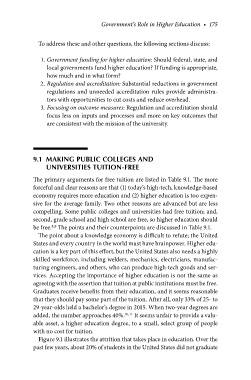Page 204 - Crisis in Higher Education
P. 204
Government’s Role in Higher Education • 175
To address these and other questions, the following sections discuss:
1. Government funding for higher education: Should federal, state, and
local governments fund higher education? If funding is appropriate,
how much and in what form?
2. Regulation and accreditation: Substantial reductions in government
regulations and unneeded accreditation rules provide administra-
tors with opportunities to cut costs and reduce overhead.
3. Focusing on outcome measures: Regulation and accreditation should
focus less on inputs and processes and more on key outcomes that
are consistent with the mission of the university.
9.1 MAKING PUBLIC COLLEGES AND
UNIVERSITIES TUITION-FREE
The primary arguments for free tuition are listed in Table 9.1. The more
forceful and clear reasons are that (1) today’s high-tech, knowledge-based
economy requires more education and (2) higher education is too expen-
sive for the average family. Two other reasons are advanced but are less
compelling. Some public colleges and universities had free tuition; and,
second, grade school and high school are free, so higher education should
be free. The points and their counterpoints are discussed in Table 9.1.
8,9
The point about a knowledge economy is difficult to refute; the United
States and every country in the world must have brainpower. Higher edu-
cation is a key part of this effort, but the United States also needs a highly
skilled workforce, including welders, mechanics, electricians, manufac-
turing engineers, and others, who can produce high-tech goods and ser-
vices. Accepting the importance of higher education is not the same as
agreeing with the assertion that tuition at public institutions must be free.
Graduates receive benefits from their education, and it seems reasonable
that they should pay some part of the tuition. After all, only 33% of 25- to
29-year-olds held a bachelor’s degree in 2015. When two-year degrees are
added, the number approaches 40%. 10,11 It seems unfair to provide a valu-
able asset, a higher education degree, to a small, select group of people
with no cost for tuition.
Figure 9.1 illustrates the attrition that takes place in education. Over the
past few years, about 20% of students in the United States did not graduate

